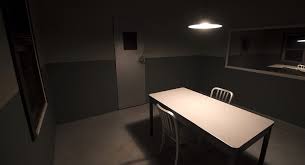← Back to Main
Two-Rooms Problem: Interrogation Room
7/28/2024, 2:52:15 AM | Jeanyoon Choi

Original Notes (Pre-LLM)
Multi-Device Web Artwork: One of possibility: Inter-Rooms/Inter-spatial layout
Where interconnected devices span and communicate across the space, inter-the-space, beyond-the-space
Physically disconnected rooms → How to create a narrative which spans across different rooms?
Or even different country? Spanning across the world?
Nam June Paik: Good Morning Mr.Orwell
How to implicitly signify that different spaces are communicating in real-time?
A good place to start: Interrogation room
An asymmetrical setting where being seen - the act of watching is divided. One room is a subject (being seen), and another room is an active place of gazing (the act of seeing/controlling).
Interrogation room: One-way glass makes one room to be subjective to another / controlled by another. Room A (노출되는), Room B (조절하는), Room A (을), Room B (갑).
Such an interesting structure that human had made, 위계적 구조를 여과 없이 들어내는, 갑-을의 구조, 힘에의 의지가 작동하는 방향성이 단방향으로 정해진 형태.
Appliance to MDWA Installation Settings:
The audience first enter Room A (Incognito for the whole structure) and is placed in the middle of the digitally augmented space
Contents shown here are actually being controlled by Room B, and audiences are expected to suspect this in some extent
Audience later enter Room B and recognise what was happening at Room A
It might worth checking Lacan’s theory on gazing → Point of Light - Screen - Subject
English Version (LLM-Generated)
Considering the concept of multi-device web artwork, there is a possibility to explore inter-room or inter-spatial layouts. This entails creating systems of interconnected devices that span and communicate across different spaces and even beyond. It could involve physically disconnected rooms, creating a narrative that spans across different countries or even the world.
The question is how to subtly imply that different spaces are communicating in real-time. Artist Nam June Paik's "Good Morning Mr.Orwell” could serve as an inspiration. We might consider an interrogation room as the starting point.
This is an asymmetrical setting, where the roles of being seen and the act of watching are divided. Between two rooms, one becomes the subject (being seen) while the other takes an active role in gazing (the act of seeing or controlling). In this context, a one-way glass makes one room subjective to the other, controlled by it. This fascinating structure vividly uncovers power dynamics and the direction of will.
When applying this concept to a multi-device web artwork installation, the audience first enters Room A and is placed in the middle of a digitally augmented environment. Content shown here is controlled by Room B, hinting at certain suspicions to the audience. Eventually, the audience enters Room B and recognizes what was happening in Room A. It might be beneficial to explore Lacan’s theory on gazing, specifically the points of light, screen, and subject.
Korean Version (LLM-Generated)
다중 장치 웹 아트워크: 가능성 중 하나: 방 간/공간 간 배열
상호연결된 장치들이 공간을 가로지르고, 공간을 초월하여 소통하는 장소
물리적으로 분리된 방들 → 어떻게 다른 방들을 가로지르는 서사를 만들 수 있을까?
혹은 다른 나라를 가로지르는 방법은? 전 세계를 가로지르는 방법은?
백남준: Good Morning Mr.Orwell
어떻게 다른 공간들이 실시간으로 소통하고 있다는 것을 함축적으로 표시할 것인가?
시작하기 좋은 장소: 심문실
보고 있다는 행위가 나눠진 불균형한 설정. 한 방이 피조사자(피관찰자)이고, 다른 방이 주시하는 활동의 장(관찰/통제하는 행위).
심문실: 일방통행 유리는 한 방이 다른 방에게 주관적이거나 / 통제당하게 만듭니다. 방 A (노출), 방 B (조절), 방 A (피관찰자), 방 B (관찰자).
인간이 만든 이러한 흥미로운 구조, 필터 없이 뚜렷한, 갑과 을의 고정된 구조, 힘이 작용하는 방향성이 단방향으로 정해져 있다는 점.
MDWA 설치 설정 적용:
관객은 처음에 방 A (전체 구조에 대해 익명)에 들어가고, 디지털적으로 확장된 공간 중간에 위치하게 됩니다.
여기에 표시되는 내용은 실제로 방 B에서 제어되며, 관객들은 이를 어느정도 의심하게 됩니다.
관객은 나중에 방 B로 들어가고 방 A에서 무슨 일이 일어났는지를 인식하게 됩니다.
라칸의 관조 이론을 확인해 볼 만한 가치가 있을지도 → 빛의 지점 - 화면 - 주체
Tags
Multi-Device Web Artwork
inter-room
inter-spatial layout
Nam June Paik
Good Morning Mr.Orwell
interrogation room
asymmetrical setting
one-way glass
노출되는
조절하는
을
갑
위계적 구조
갑-을의 구조
힘에의 의지
MDWA
installation settings
Lacan
gazing
Point of Light
Screen
Subject
Text written by Jeanyoon Choi
Ⓒ Jeanyoon Choi, 2024